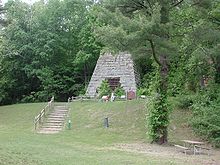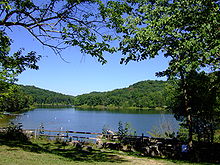Lake Hope State
Park-Hocking Hills, Ohio
 A
natural paradise, Lake Hope State Park lies
entirely within the 18,200-acre Zaleski
State Forest in the valley of Big Sandy Run.
It is a rugged, heavily forested region
traversed by steep gorges and narrow ridges.
Abandoned mines, ancient mounds and
beautiful scenery provide interest and
pleasure for hikers, photographers, nature
lovers and historians alike at one of Ohio's
most historic and scenic state parks. A
natural paradise, Lake Hope State Park lies
entirely within the 18,200-acre Zaleski
State Forest in the valley of Big Sandy Run.
It is a rugged, heavily forested region
traversed by steep gorges and narrow ridges.
Abandoned mines, ancient mounds and
beautiful scenery provide interest and
pleasure for hikers, photographers, nature
lovers and historians alike at one of Ohio's
most historic and scenic state parks.
Nature of the Area
Lake Hope State Park is truly a nature
lover's dream. In the forest-draped hills,
the observant visitor can discover the
abundant natural resources of this wild and
scenic park.
Although most of the forest was cut to fuel
the iron smelting industry that once
flourished here, the land has recovered and
supports a magnificent, second-growth
forest. Oak and hickory are the dominant
trees while the woodland floor harbors a
fascinating assemblage of shrubs and
wildflowers. The yellow lady's slipper ,one
of the rarest and most showy orchids, blooms
in secluded hollows. Other spring
wildflowers such as blue-eyed mary,
bloodroot and wild geranium can be found in
abundance.
Deer and wild turkeys are often seen in a
number of park locations. Of the many
animals inhabiting the park, none is as
popular as the beaver. As nature's dam
builders, the beavers are found in numbers
and can be observed near the quiet inlets of
the lake.
History
of the Area
Though the roar of the iron furnaces no
longer echoes through the hills of Vinton
County, there are many reminders of days
gone by at Lake Hope State Park. Situated at
the heart of Ohio's Hanging Rock iron
region, Lake Hope State Park reflects the
rich history of much of southeastern Ohio.

The Hope Furnace was built here over 100
years ago to process the iron ore extracted
from the region's sandstone bedrock. The
iron resulting from the ore smelting process
was used to produce many different items,
including ammunition and cannon for the
Union Army during the Civil War. Hundreds of
men labored cutting timber, working the
furnace and driving teams of mules hauling
iron ore to the furnace. Charcoal fires were
tended 24 hours a day; so much wood was
required for this process that the
surrounding hillsides were almost completely
stripped of their timber. At the height of
the Hope Furnace's production, Ohio was one
of the nation's leading producers of iron.
As time passed, iron ore was discovered
farther west and Ohio's reputation as a
major iron producer waned.
By 1900, nearly all of the major furnaces in
southern Ohio were shut down. Today, the
Hope Furnace chimney and some of the
foundation are all that remain of the
structure. In the vicinity of the chimney,
one may find pieces of slag, the cast-off
residue from the smelting process. These
pock-marked, glass-like piece shave now
become a part of the forest floor. The
forest we now see is one that has grown back
where hundreds of years ago a primeval
forest once stood.
For a time, coal was an important Vinton
County export. A number of mines tunneled
into the hills and large quantities of coal
were transported out in ox-drawn coal cars.
Most of the mines were abandoned early in
this century.
Lake Hope State Park was created in 1949
when the Division of Parks and Recreation
came into existence.
|
|